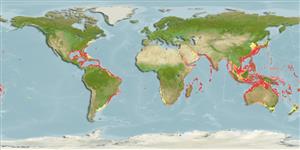Common names from other countries
Environment: milieu / climate zone / depth range / distribution range
Ecología
marino demersal; rango de profundidad 30 - 270 m (Ref. 11230). Tropical
Widespread in the Indo-West Pacific: and Atlantic.
Tamaño / Peso / Age
Maturity: Lm ? range ? - ? cm
Max length : 60.0 cm TL macho / no sexado; (Ref. 124490)
Vértebra: 119 - 130. This species is distinguished by the following characters: presence of pectoral fin; dorsal-fin origin is slightly anterior to pectoral-fin base, predorsal length 10.7-13.1% TL; anus anterior, below tip of pectoral fin, preanal length 15.9-18.9% TL; very short trunk, 2.8-5.5% TL; intermaxillary teeth 2; compound teeth on vomer 4; single row of 9-11 large compound teeth on lower jaw; head pores: IO 4, SO 3; M 6; POP 0; AD 1, F 0, ST 0; lateral-line pores: predorsal 3-6, prepectoral 6-9, preanal 8-12, total 57-75, the last at posterior two-thirds of total length; MVF 8-14-124, total vertebrae 119-128 (up to 130 in Robins & Robins, 1989) (Ref. 106136).
Inhabits coastal waters. Prefers muddy bottoms, often off mouths of large rivers.
Life cycle and mating behavior
Maturities | Reproducción | Spawnings | Egg(s) | Fecundities | Larva
Castle, P.H.J., 1986. Synaphobranchidae. p. 188-190. In M.M. Smith and P.C. Heemstra (eds.) Smiths' sea fishes. Springer-Verlag, Berlin. (Ref. 3973)
IUCN Red List Status (Ref. 130435)
Can't connect to MySQL database (fbapp). Errorcode: Too many connections
